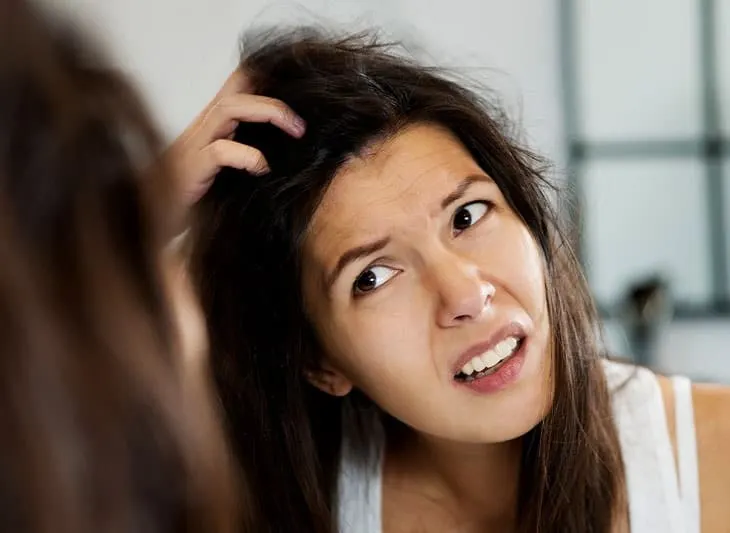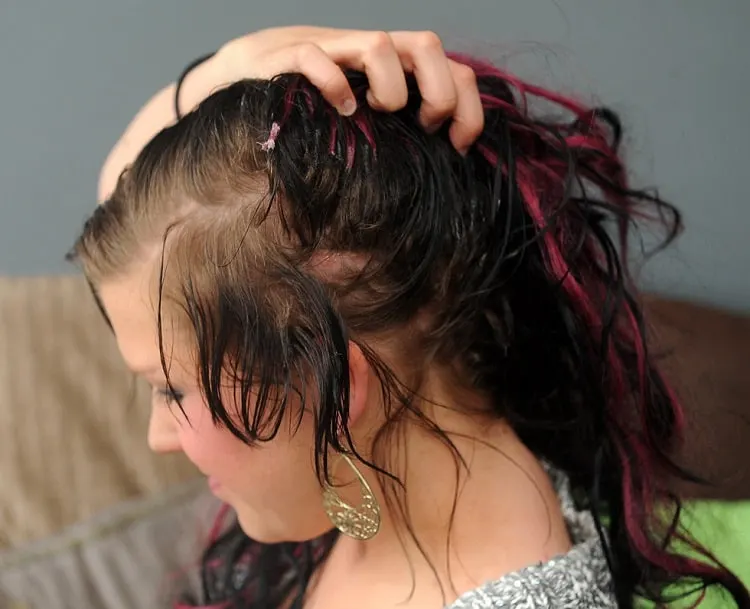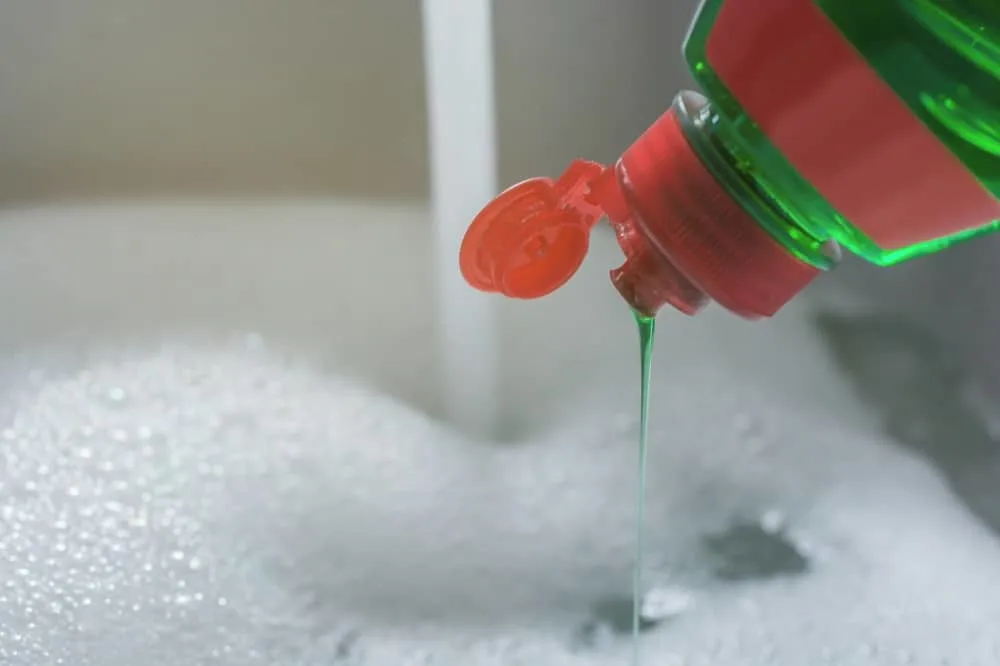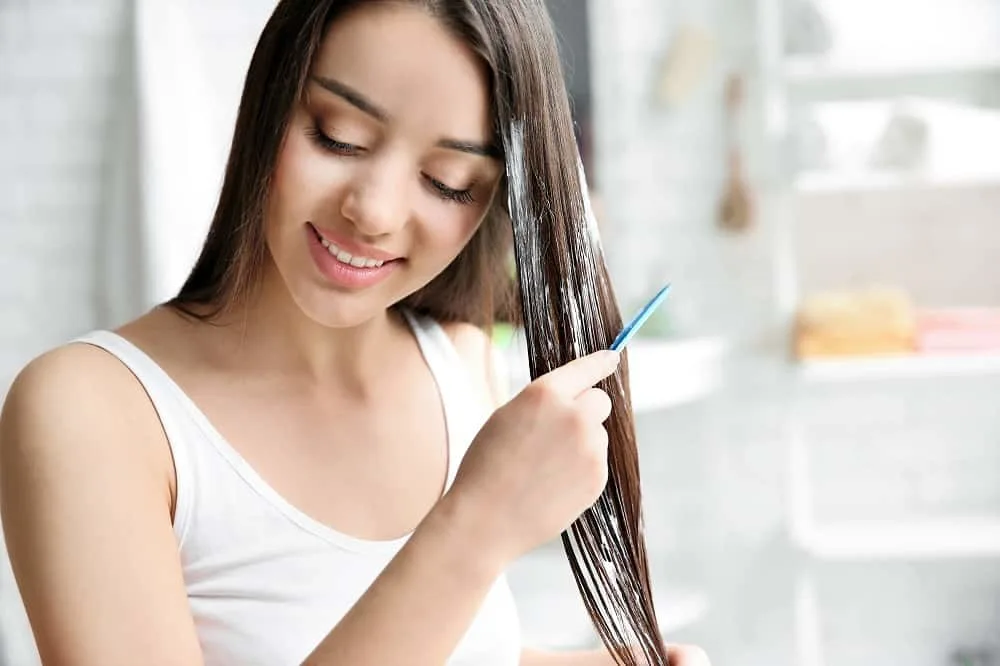When you buy through links on our site, we may earn an affiliate commission.
If you’ve ever used hair weaves, extensions, or wigs, you probably understand the importance of using hair glue to attain and maintain your favorite hairstyle. That said, you’re probably also concerned about how to remove glue from your hair.
While hair glue does an excellent job of securing wigs and other hairpieces, it can be challenging to remove it when you’re ready to change your hairstyle.
Hair glue ensures that your “fake hair” looks healthy, realistic, and natural while keeping everything in place for the life of your look, which can be as long as two months.
But removing hair glue doesn’t have to be a crisis. With a bit of patience and confidence, and some good techniques and products, you can remove excess hair glue without damaging your tresses.
Is Hair Bonding Glue Bad for Your Hair?

Yes, glue can cause permanent damage to the hair, either from not removing it at all or by removing it using aggressive methods or harsh products. Hair bonding glue may also cause problems to the scalp because it can burn and block your hair follicles.
Its ingredients include high concentrations of toxic chemicals that can burn and dry out hair, and its fumes can cause anaphylaxis reactions in people with allergic sensitivities.
How to Remove Glue From Hair

If you’ve attempted to remove glue from hair with plain water, you’ve likely realized that doing it this way is an exercise in futility.
Fortunately, there are some tried and true (and safe!) ways to remove hair glue. Some of them are so fortifying that they also nourish and condition the hair and scalp in addition to removing the glue.
It might be necessary to experiment with different removal approaches, depending on the specific hair glue that was used.
Your hair’s original texture, type, and condition can also play a role in which type of removal method will work best for you.
Because there are so many options, we’ve decided to list them here in order of simplicity and product accessibility.
To learn how to get glue out of hair, work your way through this list until you land on the method that’s best for you.
Method #1 – Your Normal Shampoo Routine with a Twist
Good old-fashioned shampoo and conditioner might do the trick, so start with this method. However, this time mix equal parts of both products and apply them to your wet hair generously.
Pay special attention to the sections that have the glue, and massage it well to those areas. Let it sit for 10 minutes.
As you rinse it out, use a wide-toothed comb to remove the loosened glue. If you see that the process is working, repeat as often as necessary until all the glue is removed. As you continue, use a narrow-toothed comb to remove even more glue.
When finished, deep condition your hair to restore healthy PH levels that might have been stripped due to excessive shampooing.
Method #2 – Ice-Ice Baby – Safe and Secure

Another simple glue removal technique that doesn’t require any special ingredients is the use of ice. Ice hardens glue, making it easier to snap off your hair with your fingers and remove it with a comb.
Fill a small disposable plastic cup with water. Place a popsicle stick or a spoon in the cup and freeze.
Once frozen, remove the “popsicle” from the cup, using the spoon as a handle.
Cover your shoulders with a towel to prevent your clothes and the floor from getting wet. Apply the ice to all the sections of your hair where there is glue. Remove the hair glue with your fingers and comb through.
Method #3a – Rubbing Alcohol Might Do the Trick
Who doesn’t have 70% rubbing alcohol in their medicine cabinet, especially these days? It’s cheap, easy to get, and can work miracles on hair that is caked with glue.
Saturate a few cotton balls with alcohol and place them in the areas of your hair where there is glue. Leave them in position for at least 10 minutes; to keep them from falling out, use bobby pins or even paper clips.
If the glue is very thick and dry, you may need to leave the cotton balls on for a bit longer but don’t exceed 20 minutes total, as alcohol can be very drying to the hair and scalp.
Once the alcohol has done its magic; the glue begins to disintegrate. Rub the affected sections of hair with your fingertips, and gently remove the loose pieces of adhesive.
Use a narrow-toothed comb to remove the smaller pieces. After you have successfully removed the glue, wash and condition your hair as usual to combat the alcohol’s drying effects.
Method #3b – Nail Polish Remover
See Method #3a and follow the same steps, but use nail polish remover instead.
Method #4 – Dish Soap

Certain brands of dish soap, like Dawn Ultra Dishwashing Liquid Dish Soap are known for their powerful grease-cutting formulations. To make the most of those properties, lightly moisten the affected areas of your hair with a little warm water.
Use a generous amount of dish soap and massage it into the sections that have glue. Make sure the hair is well-saturated with the soap, cover your head with a plastic bag or some clear wrap, and leave it in for one hour.
Before rinsing out the soap, use your fingers and a narrow-toothed comb to remove the pieces of glue. Shampoo and deep condition to restore moisture to your hair.
Method #5 – Crushed Aspirin
Crushed aspirin is the main attraction in this household concoction that can help remove stubborn hair glue.
Crush 10 aspirin tablets and mix them with 2 tablespoons of shampoo and 4 tablespoons of witch hazel. Apply the mixture to the areas affected by glue and massage it in with your fingers.
Leave the solution on your hair for 30 minutes and comb through with a narrow-toothed comb. Rinse and repeat as many times as needed.
Once all the glue is removed, shampoo and deep condition with a hydrating mask.
Method #6 – Coconut Oil, Vaseline, or other Lubricant

Rub some coconut oil, Vaseline, or another lubricant, such as butter, over the bits of glue, and leave for at least one hour. Comb gently and use your fingers to remove the pieces of glue. Shampoo and condition as normal.
What you don’t do can’t hurt you! The best way to avoid the hassles of removing glue from hair is not to use it in the first place.
Many glue-free options are available to change your hairstyle or lengthen your hair. Clip-in, tape-in, or micro-ring extensions, or sew-in weaves or wigs, are just some of the ways you can extend the length of your hair and change your look without having to use glue.
FAQs
Hair glue is also known as hair bonding glue and is used to bond hair extensions to existing hair. It is a latex- or rubber-based adhesive and one of the most effective methods to attach extensions.
Hair glue can generally remain 1-2 weeks with a maximum of three weeks. Exactly how long it lasts depends on the oiliness of your scalp and the amount of oil-based product applied to your hair.
Oil is effective for removing glue from hair, whether you use baby oil or olive oil, avocado oil, or almond oil. The oil should be left on the scalp for 15-20 minutes to give it time to deactivate the adhesive as much as possible.
While perm solution may affect hair glue, removing it is not a good option. With some caution, it is possible to perm hair without affecting the weave bond, so don’t turn to a perm solution to remove the glue.
Yes, you can use apple cider vinegar. The vinegar will break down the bond between the hair strands and the glue. Using a cloth or cotton ball, press the vinegar into the hair glue and let it sit for a few minutes. After that, the glue will soften, and you can gently take it out using a comb.
Hair glue can cause safety or cosmetic concerns, which you should be aware of before using it. It can do damage to your scalp, which can be permanent. The adhesive does not allow your hair to “breathe.”
It also blocks the pores in your scalp, which can dry out your hair and damage your hair follicles. Most glues for hair contain soluble latex in significant amounts, so if you have an allergy to latex, this is not safe for you to use.
You should be aware of the ingredients in the glue you will use, as many of them contain several chemical ingredients that can cause side effects. Depending on the extension’s length and weight, they can also pull on your scalp and cause your hair to thin.
Traction alopecia is a specific hair loss resulting from constant pressure on the hair follicle, caused by hair extensions and certain types of wigs or hairstyles. Longer and heavier extensions carry more risk of traction alopecia because they place more pressure on the hair.
Hair loss is more common around the hairline since the hair is more delicate in that area.
The constant pressure from the extra weight on your scalp can cause some people to have headaches. The heavier the extensions or weave, the more likely you will experience headaches from the added pressure.
Additionally, the chemicals in glue can cause headaches as you inhale them, which will vary by individual and how sensitive you are to the specific ingredients in the hair glue used.
Related Topics:
